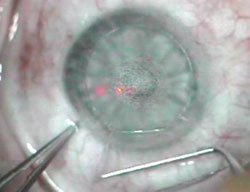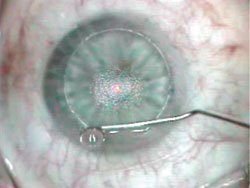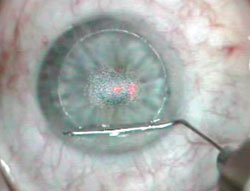Thin LASIK flaps require careful handling
Two-handed technique results in greater globe stability and control with the dissection spatula and avoids unwanted hemorrhage.
Introduction
 Thomas John |
Ocular pain, corneal haze and epithelial healing are some of the primary concerns of ocular surface ablative procedures such as PRK. With LASIK, the focus shifts to flap-associated potential complications such as striae, tears, free-cap, neuronal compromise, interface debris, epithelial ingrowth and alterations in the biomechanical properties of the human cornea.
In an attempt to take advantage of the LASIK procedure and minimize the potential complications, one of the surgical trends has been toward the creation of a thin flap. Compared with a thicker flap, the handling of such a flap requires special attention.
In this article, George O. Waring IV, MD, describes the techniques that may be helpful in the proper handling of a thin LASIK flap and the prevention of iatrogenic damage.
– Thomas John, MD
OSN Surgical Maneuvers
Editor
 George O. Waring IV |
Advances in research and technology have spawned new trends in vision correction.
In recent years, thin-flap LASIK, also known as sub-Bowman’s keratomileusis, or SBK, has gained popularity, and studies have suggested that thin-flap LASIK offers the benefit of rapid visual recovery while providing a biomechanical outcome and corneal sensitivity within the limits of current assessment similar to surface ablation. We currently recommend a flap thickness of 100 µm to 110 µm.
Surgical techniques
Thin LASIK flaps can be handled safely by following a few basic surgical principles.
A two-handed technique that fixates the globe with 0.12 forceps in the nondominant hand while avoiding conjunctival vasculature (to prevent hemorrhage) during the flap lift results in greater globe stability and control with the dissection spatula.
Limbal fixation also provides for countertraction while separating interface micro-adhesions associated with femtosecond lasers (Figure 1). When lifting thin flaps, it is critical to initiate and maintain a slight downward angle with the spatula tip to prevent epithelial defects, flap tears and punctures (Figure 2).
Once the interface is entered, initially dissect toward the hinge and then continue to the inferior portion of the flap (for superior hinges) without exiting the interface. Proceed with the lamellar dissection and leave the inferior most portion of the interface attached, which provides flap countertraction and allows an easier and more orderly dissection.
 Figure 1. Limbal fixation with 0.12 forceps results in greater globe stability and countertraction. Avoid vasculature to minimize hemorrhage. |
 Figure 2. When lifting thin flaps, it is critical to initiate with and maintain a slight downward angle with the spatula tip to prevent epithelial defects, flap tears and punctures. Images: Waring GO |
 Figure 3. With a parallel movement of the dissection spatula toward the hinge and a very slight upward lift, fold the flap in half and on itself in a taco configuration to protect the stromal side of the flap. |
 Figure 4. After the excimer ablation, place one to two drops of balanced salt solution near the hinge to keep the flap moving naturally and to prevent dehydration, then gently unfold the thin-flap taco. |
Dividing the lamellar dissection into thirds balances safety and procedure time. Avoid a single-broad dissection movement across the entire flap, which increases the risk of tearing a thin flap and flap hinge. Conversely, multiple small swipes increase procedure time, tissue manipulation and tissue dehydration.
With the final dissection pass, exit the interface on the opposite side from the entry site and complete the final peripheral and inferior separation. When lifting a thin flap, gently place the dissection spatula under the flap, parallel to the hinge, and with a slight upward lift, fold the flap in half and on itself in a taco configuration to protect the stromal side of the flap from the excimer laser (Figure 3).
Use balanced salt solution sparingly
After the excimer ablation, do not over-hydrate. Place one to two drops of balanced salt solution near the hinge to keep the flap moving naturally to prevent striae and dehydration. Next, gently unfold the taco (Figure 4).
To replace the flap on the stromal bed, carefully place the balanced salt solution cannula under the flap, adjacent and parallel to the hinge, using a few drops of balanced salt solution on the epithelium as a cushion to avoid iatrogenic abrasions with the cannula tip (Figure 5). Carefully lift the flap parallel to the hinge, off the cornea, with the aforementioned balanced salt solution lubrication, and place the flap onto the stromal bed with a single uniform stroke.
 Figure 5. Carefully place the balanced salt solution cannula under the flap, adjacent and parallel to the hinge, using a few drops of balanced salt solution as a cushion to avoid abrading the epithelium. |
Iatrogenic epithelial defects from the cannula tip are typically self-limited and benign, although they may occasionally result in brawny edema or focal inflammation and delayed healing. In this case, topical steroids may be titrated as needed.
Once the flap is back into position, wipe the balanced salt solution cannula tip to remove debris and epithelial cells, then re-enter the interface to float the flap with the cannula using only a few drops of balanced salt solution to avoid the common mistake of over-hydrating the stroma. Again, maintaining a parallel orientation between the cannula and hinge during this step will facilitate gutter symmetry, which can be slightly more challenging to achieve when compared with working with thicker flaps, as there is less “tissue memory.”
To remove interface fluid and seat the lamella into its proper position, stroke the cannula over the anterior surface of the flap, starting parallel to the hinge and moving inferiorly. Next, using a moistened Weck-Cel spear (Medtronic Xomed), follow the contour of the cornea with two or three broad strokes to ensure gutter symmetry, removal of interface fluid or flap striae.
As with traditional LASIK, immediately refloat the flap if there is obvious gutter asymmetry, striae or debris found in the visual axis. Complete the procedure with application of a few seconds of compressed air, which allows the flap to seal and exposes Bowman’s crinkles. Postoperatively, surgeons are encouraged to have a low threshold to refloat flaps with potentially visually significant striae or microstriae.
The principles described in this article can be easily integrated into a traditional LASIK routine and will facilitate surgeons’ transition to working with thin LASIK flaps.
References:
- Durrie DS, Slade SG, Marshall J. Wavefront-guided excimer laser ablation using photorefractive keratectomy and sub-Bowman’s keratomileusis: a contralateral eye study. J Refract Surg. 2008;24(1):S77-84.
- Pirouzian A, Thornton J, Ngo S. One-year outcomes of a bilateral randomized prospective clinical trial comparing laser subepithelial keratomileusis and photorefractive keratectomy. J Refract Surg. 2006;22(6):575-579.
- Waring GO 4th, Durrie DS. Emerging trends for procedure selection in contemporary refractive surgery: consecutive review of 200 cases from a single center. J Refract Surg. 2008;24(4):S419-423.
- Thomas John, MD, is a clinical associate professor at Loyola University at Chicago and is in private practice in Tinley Park and Oak Lawn, Ill. He can be reached at 708-429-2223; fax: 708-429-2226; e-mail: tjcornea@gmail.com.
- George O. Waring IV, MD, is a clinical assistant professor of ophthalmology at Emory University School of Medicine and is in private practice in Atlanta. He can be reached at georgewaring@earthlink.net.

